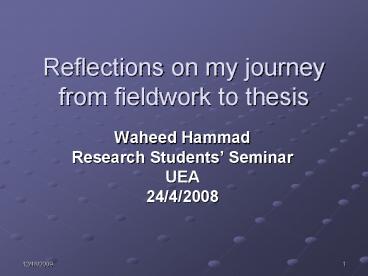Reflections on my journey from fieldwork to thesis - PowerPoint PPT Presentation
1 / 9
Title:
Reflections on my journey from fieldwork to thesis
Description:
Data analysis is a complex and time-consuming task. ... and reporting my participants' perceptions of the issue under investigation. ... – PowerPoint PPT presentation
Number of Views:25
Avg rating:3.0/5.0
Title: Reflections on my journey from fieldwork to thesis
1
Reflections on my journey from fieldwork to thesis
- Waheed Hammad
- Research Students Seminar
- UEA
- 24/4/2008
2
- Data analysis
- the process of bringing order, structure, and
interpretation to the mass of collected data
(Marshall and Rossman,1999) - It involves making sense of the data in terms
of the participants definitions of the
situation, noting patterns, themes, categories
and regularities (Cohen et al., 2007)
3
- Analysis during data collection
- In the course of fieldwork, ideas about
directions for analysis will occur. Patterns take
shape. Possible themes spring to mind. Hypotheses
emerge that inform subsequent fieldwork (Patton,
2002). - Listening to the interviews and transcribing them
on a daily basis. - Picking up the emerging themes.
- Initial themes were useful in reshaping the
remaining interviews and provided a basis for
subsequent data analysis.
4
- Analysis after data collection
- Data analysis is a complex and time-consuming
task. It is the most mysterious aspect of
qualitative research (Maxwell, 2005) - Qualitative analysis is particularly difficult
for a would-be qualitative researcher who can
see the merits of a qualitative approach to data
generation , but is less clear about what can be
done with the products (Mason, 2002)
5
- Organizing the data using MaxQDA
- The analysis of qualitative data involves
creativity, intellectual discipline, analytical
rigor, and a great deal of hard work. Computer
programs can facilitate the work of analysis, but
they cant provide the creativity and
intelligence that make each qualitative analysis
unique. (Patton, 2002) - Entering interview transcripts into the
programme. - Creating seven text groups based on the seven
categories of participants.
6
- Data coding
- the formal representation of analytic
thinking (Marshal Rossman, 1999). It involves
devising a consistent system for indexing the
whole of a data set according to a set of common
principles and measures (Mason, 2002) - During this process, categories (or codes) are
generated and then chunks of data are indexed (or
coded) according to generated categories. - Reading through the data to seek the shape of
the forest amid the trees (Gerson Horowitz,
2002). - Generating categories (codes) as reading
progresses.
7
- Revisiting the coding system using the
flexibility of MaxQDA. - Coding outcome 204 categories allocated to 3375
text segments. - Retrieving coded data segments.
- Conducting first level analysis examining,
comparing and reporting my participants
perceptions of the issue under investigation. - Emerging little interesting issues.
- Conducting second level analysis digging deeper
into my participants responses in order to
interpret the meanings of their experiences.
8
- Document analysis
- Three types of school documents were analyzed
- Minutes of meetings of school boards.
- Minutes of meetings of the boards of trustees.
- Minutes of meetings of the undersecretary
with secondary head teachers. - Objectives
- Building a model of decision-making in the sample
schools. - Exploring the idea of centralized control.
9
- Analysis outcome 150 pages of analysis
- Identifying the big themes that form the
thesis. - Three themes were identified
- A model of decision-making in the sample schools.
- The school culture as it relates to SDM.
- Response to structural change.































